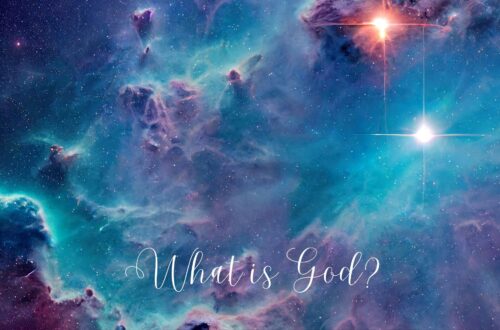
What is God ?
The concept of God varies greatly among different belief systems and philosophical perspectives. Where God is portrayed as the pinnacle of pure consciousness and the presence of existence. This aligns with a perspective often found in Eastern spirituality and some forms of mysticism.
In the worldly dimension, God is often seen as the ultimate source and essence of all existence. It is the underlying, unifying force that permeates the entire universe, holding it together in perfect harmony. What is God? If not an external deity with human-like characteristics but rather the very fabric of reality itself.
God is the embodiment of pure consciousness, transcending all boundaries and limitations. It represents the highest state of awareness and spiritual realization attainable by human beings. When individuals experience God in this dimension, it is akin to a profound sense of unity with all of creation. It is the recognition that their own consciousness is inseparable from the universal consciousness, and that they are an integral part of the grand tapestry of existence.
In this sense, what if God becomes a deeply personal and subjective experience. The sublime realization that one’s own existence is intimately connected to the vast cosmos. The boundaries between self and other, individual and universe, dissolve into a state of oneness. God, in the worldly dimension, is the highest expression of human consciousness, transcending ego, desires, and separateness, and embracing the profound interconnectedness of all that exists.
It’s important to note that this perspective of God may differ from more traditional religious views, and interpretations of God’s identity can vary widely among individuals and cultures. However, it emphasizes the idea of God as the ultimate realization of pure consciousness and the unity of all existence.
What is the definition of God?
In the worldly dimension, the identity of God can be understood as follows: A self-realized person consistently lives their life with an enduring sense of aliveness and bliss. Regardless of the circumstances, challenges, or paths that life may present, this individual maintains a constant state of bliss. This perpetual mood of blissful-aura permeates their existence.
For such a person, the experience of life is not limited by external conditions. Instead, their inner state of being remains unshaken, radiating a continuous sense of joy and contentment. This mood of blissful-aura is their way of interacting with the world, infusing every moment with a profound and unwavering sense of well-being.
God is seen as the embodiment of blissful-aura. The self-realized individual reflects the divine essence through their perpetual state of joy and aliveness. Their life serves as a testament to the potential for humans to transcend the ups and downs of worldly existence and connect with a deeper, more profound dimension of reality characterized by constant bliss and awareness.
In the worldly dimension, God can be understood as the highest state of human consciousness. Where one’s inner state remains untouched by external circumstances, and the predominant mood is one of unending joy and contentment.
What is the definition of God for atheism?
Truth is a universal concept that applies to everyone, whether they are believers or atheists. The way individuals approach truth may differ, but the essence of truth itself remains consistent.
Theistic individuals often seek to understand truth through external subjects, such as religious texts, teachings, and divine revelations. They believe that these external sources provide insights into the nature of reality, morality, and the divine.
On the other hand, atheists typically approach truth by relying on their own critical thinking, reasoning, and empirical evidence. They often make themselves the subject of inquiry and base their understanding of reality on scientific, logical, and experiential observations.
While the paths to truth may vary, the fundamental principle remains that truth itself is objective and consistent, irrespective of one’s belief system or approach. It is the pursuit of truth and the methods used to uncover it that may differ among individuals. The ultimate goal is to discover a deeper understanding of the world and our place within it.
How does science define God?
In contemporary times, science and individual religious beliefs often share a common perspective when it comes to exploring the divine or understanding the fundamental aspects of existence. They both approach the concept of the divine with similar methods of inquiry.
Science, in its pursuit of understanding the natural world, also seeks to uncover the underlying principles and mechanisms governing the universe. It does so primarily by observing and studying external objects and phenomena. In this sense, science can be seen as a form of theism because it explores the divine or the fundamental aspects of existence through an external, empirical approach.
Individual religious beliefs often involve external subjects, such as spiritual guides or teachings (referred to as ‘Guru’ and ‘Dharma’ in some traditions). They serve as intermediaries in the quest for divine understanding.
Science, in its exploration of the cosmos, often uses space as a medium to observe and analyze the universe. Scientists rely on instruments and observations made from within the universe to gain insights into its workings.
Both science and individual religious beliefs share a common goal of seeking deeper understanding, albeit through different approaches. Science explores the divine or the fundamental nature of reality through empirical observation and the study of external objects. While individual religion often relies on spiritual guidance and teachings as the path to divine insight.
It’s important to note that these approaches may coexist or diverge, and individuals may choose to embrace one or both paths in their quest for a deeper understanding of existence. Ultimately, the pursuit of knowledge and meaning remains a fundamental aspect of both scientific and spiritual endeavors.
Is God invisible?
God is a multifaceted and omnipresent entity, manifesting in various forms and states. In this perspective:
Form and Formless: God takes on both form and formlessness, suggesting a duality where God can be perceived with attributes or as an abstract, unmanifested presence.
Color and Colorless: God can be associated with different attributes or qualities (color) and simultaneously exist as an attributeless, transcendent essence (colorless).
Day and Night: God is present in both the light and darkness of existence, symbolizing that divinity is not limited to moments of joy and clarity but also encompasses times of challenge and adversity.
Happiness and Sorrow: God is found in moments of happiness and moments of sorrow, emphasizing that the divine is not confined to positive experiences but is also present in the depths of human suffering.
God’s nature is all-encompassing, and the divine presence is not limited to a single, rigid form but permeates every aspect of life. It acknowledges the duality of the corporeal (physical) and incorporeal (spiritual) aspects of God. Coexist and are ever-present in our existence.
God is not constrained by human limitations or categories but transcends all boundaries, encompassing the entirety of human experience and the universe itself. It invites a holistic and inclusive understanding of divinity that embraces all facets of existence.
What is the formula of God?
Consciousness + Alive + Peace + Emptiness = God
Consciousness: the secret of deep receptivity, consciousness portrays as a fundamental aspect of existence. It is the quality that allows us to be profoundly aware and open to the experiences of the universe. This perspective suggests that the entire universe is a kind of enigmatic trap or container within which consciousness resides.
Aliveness: Aliveness is characterized as a combination of deep subtlety, tenderness, and sensitivity. Its touch is described as akin to a gentle mist, implying a sense of vitality and awareness that is delicate and perceptive.
Peace: This state is depicted as a complete absence of the experience of self. Instead, there is only a perspective or view, and the seer is inseparable from the view itself. It points to a state of profound detachment and tranquility, where the sense of individual self dissolves into non-dual awareness.
Emptiness: The visible world is perceived as a magical emptiness. The material world, while appearing solid and tangible, is ultimately insubstantial and empty. In this emptiness, there is a sense of playfulness and fullness of life, highlighting the paradoxical nature of existence.
These descriptions appear to be an exploration of deep spiritual and metaphysical themes, emphasizing the interconnectedness of consciousness, aliveness, serenity, and the illusory nature of the material world. This invites contemplation on the nature of reality, the self, and the profound mysteries that underlie our existence.
What has God got to do with death?
The analogy of life and death being like the rising and setting of the sun suggests that these are cyclical, natural processes, much like the apparent motion of the sun. It challenges us to question the absolute reality of these concepts. When one understands the dimension of death, they may transcend the cycle and embody a deeper awareness, similar to the sun “rise” and “set” but always present.
How can one see God?
Seeing God is recognizing the entire universe exists within God, akin to a fish in water. This analogy highlights the inseparability of the universe from the divine. One becomes more conscious and pure in their awareness. They draw closer to God because the essence of God is found in the deep purity of consciousness.
The contemplation on the nature of existence, consciousness, and the divine, propose that understanding and experiencing God involves a profound shift in consciousness. The boundaries of life and death, self and universe, blur, revealing a deeper, interconnected reality.
What is the first step to attain God?
The path to God is determined by the depth of this inner thirst. The intensity of one’s spiritual yearning and sincere desire to connect with the divine set the course for the journey. The presence of God is described as a feeling of vastness within the expanse of infinity. The experience of God is not confined to any limited or finite understanding but is boundless and expansive realization.
In our exploration of the concept of God and spirituality, we encounter diverse and profound perspectives. Each viewpoint offers a unique lens through which to contemplate the divine, the self, and the path to spiritual enlightenment. As we integrate these insights into our lives, we inch closer to a profound understanding of our existence and our connection to the divine.
Read about: What is Renunciation





